Lysimachos G. Papazoglou DVM, PhD, MRCVS, Vasileia Angelou DVM, MSc
Companion Animal Clinic, School of Veterinary Medicine, Aristotle University of Thessaloniki, Thessaloniki, Greece
MeSH keywords:
Greece, history, veterinary surgery
Abstract
The origins of veterinary surgery in Greece can be traced in mid-20th century, when professor I. Vikelidis of Aristotle University of Thessaloniki organized and developed academic veterinary surgery. This article attempts to describe briefly and review historical, scientific developments and practices of Greek veterinary surgery in the 20th century.
Early years (1920-1950)
In the beginning of the 20th century, veterinary surgery in Greece was performed by military veterinarians affiliated with the military veterinary service being established in the interwar era (Kardoulis 2008). All military veterinarians were graduates of European veterinary schools, received postgraduate training in Europe, and mainly practiced equine surgery (Papadaniel 1939, Κardoulis 2008). Military veterinary hospitals were built in Athens, Thessaloniki and Larisa and involved in the diagnosis and treatment of equine patients of the Greek army.
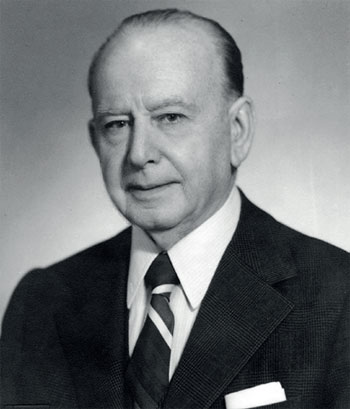 |
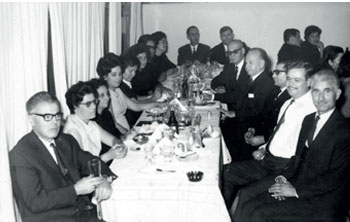 |
|
| Figure 1. Professor I. Vikelidis, the founder of Greek Veterinary Surgery (author’s LP personal files). | Figure 2. Professor and Mrs Vikelidis in a dinner with animal technicians of the Clinic and their wives (author’s LP personal files). |
First period. The beginning (1950-1970)
The advent of modern veterinary surgery in Greece is traced to professor Ioannis Vikelidis (1899-1978) of Aristotle University of Thessaloniki (Figure 1). Professor Vikelidis, a graduate of Alford France (1919-1923), became the first professor and founder of veterinary surgery, at the age of 52, in the newly established Veterinary School in Thessaloniki Greece in 1951 (Georgakis 2002). Vikelidis was a Lieutenant Colonel of the Greek Veterinary Corps before appointed Professor of Veterinary Surgery of the Aristotle University of Thessaloniki (Georgakis 2002). During his military service, Vikelidis practiced equine surgery and served as head of the Army Veterinary Hospitals in Athens and Thessaloniki. During this period Vikelidis also performed equine surgeries in private practice and gained reputation in the city of Thessaloniki (Georgakis 2002). Long before entering the academia, in 1930 Vikelidis reported vagal nerve paralysis in two horses and cauda equina neuritis in a horse (Petropoulos & Vikelidis 1930a, Petropoulos & Vikelidis 1930b). Professor Vikelidis organized and developed the Clinic of Surgery from the very beginning (Georgakis 2002) (Figure 2). In 1955 and 1956 Vikelidis wrote the first three textbooks of veterinary surgery in the Greek language (Figure 3). In 1958 he published the first Greek veterinary orthopaedics paper associated with fracture fixation in small animals (Vikelidis 1958). Two years later another monograph related to the treatment of fractures in large animals was published (Vikelidis 1960). In 1964 a keen interest in urolithiasis led to a report of three cases of bladder and urethral calculi in dogs (Vikelidis 1964).
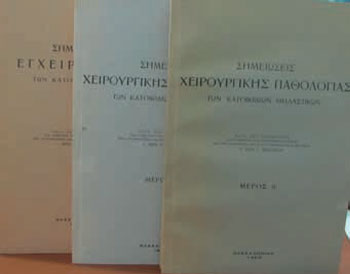 |
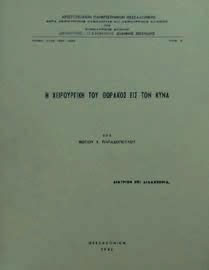 |
|
| Figure 3. Vikelidi’s textbooks of Veterinary Surgery (author’s LP personal files). | Figure 4. Papadopoulo’s PhD thesis on “Thoracic surgery of the dog” (author’s LP personal files). |
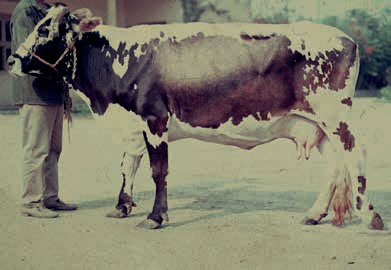 |
 |
|
| Figure 5. Upward fixation of the patella of the left hind limb in a cow (Papadopoulos & Gagatsis 1967). | Figure 6. Synthetic ring to aid in an end-to-end intestinal anastomosis in a dog (Tsiamitas 1968). |
In the early sixties new blood entered the clinic: Photios Papadopoulos DVM and Ioannis Tsiamitas DVM two promising teaching assistants. The association between human and veterinary medicine stimulated the development of specialties including surgery, radiology and anaesthesiology. Papadopoulos and Tsiamitas soon after their appointment developed a keen interest in radiology and ophthalmology and attended clinics and classes in 424 Army Hospital and in Medical School, respectively. In 1960 Burns described various techniques for performing thoracic surgery in dogs and cats, and Lumb et al. described the first lung lobectomy technique in a dog in 1965 (Burns 1960, Lumb et al., 1965). In 1963, Knight reported transthoracic oesophagotomy in a series of 75 dogs for the removal of foreign bodies (Knight 1963). In 1963 Papadopoulos published his PhD thesis entitled “Thoracic surgery in the dog” (Papadopoulos 1963) (Figure 4). Surgical management of pyloric stenosis in dogs was first described by Archibald and Mitton in 1954 (Archibald & Mitton 1954). In 1964 the first two cases of canine pyloric stenosis in Greece were reported by Vikelidis and Papadopoulos (Vikelidis & Papadopoulos 1964a). In 1940 Hoflund described vagal indigestion syndrome in ruminants (Rosenberger 1979). In 1964, Vikelidis and Papadopoulos reported two cases of functional disturbances of the stomach in ruminants caused by vagal nerve injuries (Vikelidis & Papadopoulos 1964b). In 1961, Espersen reported coecal dilatation and dislocation in the cow (Espersen 1961). In 1965, Papadopoulos described a similar case in a cow (Papadopoulos 1965). In 1965 Nikolaos Gagatsis DVM was hired as a teaching assistant in the clinic. Gagatsis was involved in bovine surgery. In 1957 Gibbens described the use of skin graft for the repair of anterior cruciate ligament rupture in dogs (Gibbens 1957). In 1967 Papadopoulos reported two cases of anterior cruciate ligament rupture in the dogs that were repaired with a skin graft (Papadopoulos 1967). In 1949, Zepp reported lateral ear canal resection for the management of otitis externa in the dog (Zepp 1949). In 1966, Papadopoulos reported a series of four dogs that had lateral ear canal resection for the management of otitis externa (Papadopoulos 1966). In 1961, upward patellar fixation was described in a cow (Curtis 1960) In 1967, Papadopoulos and Gagatsis reported a case of an upward patellar fixation in a cow that was reduced surgically by transection of the medial patellotibial ligament (Papadopoulos & Gagatsis 1967) (Figure 5). In 1967, Leighton described everting end-to-end intestinal anastomosis in dogs and Grier evaluated invagination techniques in intestinal anastomosis in dogs in 1968 (Leighton 1967, Grier 1968). In 1968 Tsiamitas published his PhD thesis entitled “An experimental method of end-to-end enteroanastomosis in the dog” (Tsiamitas 1968) (Figure 6). The first successful attempt for the repair of femoral neck fractures was reported by Cawley et al. in 1956 (Cawley et al. 1956). In 1968, Papadopoulos published his habilitation related to the experimental study of fractures of the femoral head in the dog (Papadopoulos 1968). Surgical treatment of canine hip luxation was reported by Knowles et al. in 1953 (Knowles et al. 1953). In 1969, Papadopoulos and Dessiris reported the toggle-pin technique for the management of hip luxation in two dogs (Papadopoulos & Dessiris 1969). In 1970 Angelos Dessiris DVM was appointed teaching assistant in surgery. Dessiris soon expressed a keen interest in radiology, which led him to receive postgraduate training in radiology in a human hospital for a year. In 1966 Clemente reported a technique for digit amputation in cattle (Clemente 1966). In 1969, Dessiris and Papadopoulos reported a series of seven oxes that underwent digit amputation for the treatment of long-standing claw pathology (Dessiris & Papadopoulos 1969).

Figure 7. Page 2 from the surgical case logbook of the Clinic (author’s LP personal files).
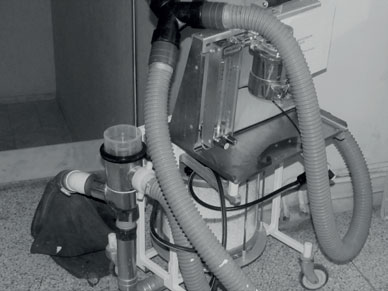 |
 |
|
| Figure 8. A large animal anaesthesia machine was purchased in late seventies and used mainly for equines (author’s LP personal files). | Figure 9. Half-hitch technique for casting an ox in mid-seventies (author’s LP personal files). |
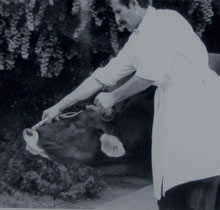 |
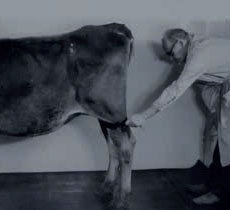 |
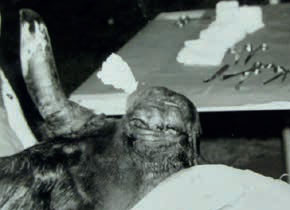 |
| Figure 10. Dimitrios Iglesis, an animal technician of the clinic of surgery, applying a nose holder in a cow (early seventies - author’s LP personal files). | Figure 11. Karayiannis, an animal technicianof the clinic of surgery is using the tail to achieve hind limb restraining (early seventies - author’s LP personal files). | Figure 12. Dehorning of a cattle (1971 - author’s LP personal files). |
During the fifties the surgical caseload of the clinic was low and consisted mainly of equines and farm animals and surgeries were performed most often under local, regional or intravenous anaesthesia (Figure 7). It was not until 1980 when the introduction of general anaesthesia with inhalant anaesthetics facilitated the development of more complicated and sophisticated surgical procedures in the equines (Figure 8). Vikelidis was mainly equine surgeon and most faculty members of the clinic were involved in large animal surgery (Figures 9-12). Faculty surgeons were hesitant to proceed in the treatment of small animal diseases, since they were lacking specialization. The need of new clinical facilities to accommodate the expansion of knowledge and caseload was recognized as early as 1958. However, the new clinic of surgery along with the laboratory of radiology was completed in early 1970. The facilities of the clinic of surgery and especially the radiology lab were comparable with those of other Western European veterinary schools. The newly constructed two-flour clinic had, among others, operating rooms for small animal orthopedic and soft tissue surgeries, a large equine operating room and many hospitalization areas. A significant increase however in small animal caseload was actually noted by the end of the sixties. These developments led Papadopoulos to visit Royal Veterinary College in London in 1963. There, Papadopoulos spent almost 18 months, as a resident, practicing small animal surgery, ophthalmology, radiology and anaesthesiology under the supervision of Professor Formston. During his stay in London, Papadopoulos and Formston published an article on the effect of alpa-chemotrypsin on the lens and retina in dogs (Papdopoulos & Formston 1965). This paper was also presented in British Small Animal Association Congress that took place in London in 1965. After the completion of his residency, Papadopoulos made short visits to the Veterinary Schools of Copenhagen, Denmark and Stockholm, Sweden and received further training in small and large animal surgery. In Denmark and Stockholm Papadopoulos spend four months and worked with Professors Obel and Espersen. Papadopoulos became Professor of veterinary surgery in 1968 following the retirement of Professor Vikelidis. Professor Papadopoulos was the founder of small animal orthopaedics, neurosurgery and ophthalmology in Greece and during his career veterinary surgery entered into a new era (Figures 13-19).
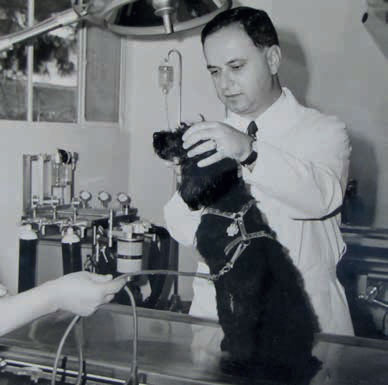 |
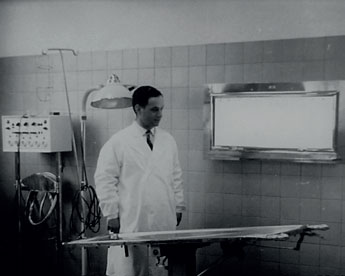 |
|
| Figure 13. Professor Papadopoulos examining a dog in the newly built Clinic of Surgery in early 1970 (author’s LP personal files). | Figure 14. Professor Papadopoulos in the newly built operating room in early 1970 (author’s LP personal files). |
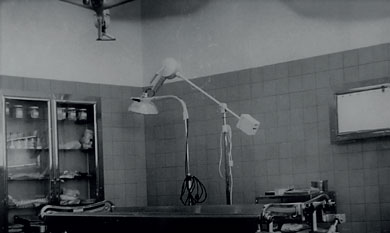 |
 |
|
| Figure 15. The soft tissue operating room of the Clinic in early 1970 (author’s LP personal files). | Figure 16. Professor Papadopoulos with other Professors ofthe Veterinary School of Thessaloniki. From left Christodoulou, Aspiotis, Tsirogiannis and Vlachos (in the background - author’s LP personal files). |
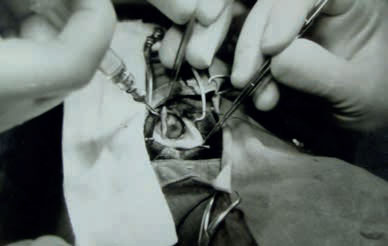 |
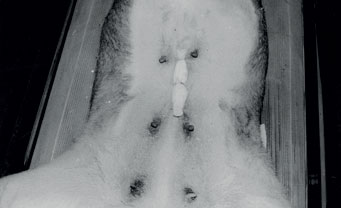 |
|
| Figure 17. Professor Papadopoulos and his team performing cataract surgery in a dog (1972 - author’s LP personal files). | Figure 18. A gauze roll placed over a laparotomy wound and secured in place with simple interrupted sutures passed through skin and subcutis. A technique used routinely in the clinic of surgery in the eighties as laparotomy wound dressing (author’s LP personal files). |
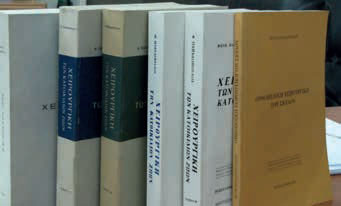
Figure 19. Papadopoulo’s textbooks of veterinary surgery
(author’s LP personal files).
Second period- stability (1970- 1990)
In 1970 Gagatsis and Dessiris reported an unusual case of intestinal strangulation through an omental rent in a cow (Gagatsis & Dessiris 1970). In 1930, Bosshart first reported intestinal intussusception in cattle (Bosshart 1930). In 1970, Papadopoulos et al. reported four cases of intestinal intussusception in cattle which received surgical treatment (Papadopoulos et al. 1970). In 1955, Seibold et al. reported a possible association between oesophageal tumors and Spirocercal lupi infection in dogs (Seibold et al. 1955). In 1971, Dessiris reported a case of megaoesophagus in a dog associated with Spirocerca lupi infection (Dessiris 1971). In 1969, Pelug and Calnan studied for the first time the normal anatomy of the lymphatics of the hind limb of dogs (Pelug & Calnan 1969). In 1971, Vlachakis-Miliaras and Dessiris studied normal lymphograms in the canine hind limb by direct lymphography (Vlachakis-Miliaras and Dessiris 1971). In 1971 Nikolaos Moustardas DVM and Theodoros Papadopoulos DVM were hired as teaching assistants in surgery. In 1952 Wiessner and Wiessner reported the first case of epiphysiolysis of the femoral head in a sow (Wiessner & Wiessner 1952). In 1971 Saoulidis and Dessiris reported another case of femoral head epiphysiolysis in a sow (Saoulidis & Dessiris 1971). Myelography in dogs was initially studied in 1936 (Brook 1936). In 1972 Dessiris published his PhD thesis related to the study of myelography in normal dogs (Dessiris 1972). In 1962 Vitums described anomalous origin of the right subclavian and common carotid arteries in the dog (Vitums 1962). In 1973 Dessiris reported a case of vascular ring anomaly in a dog associated with esophageal compression from both common carotid arteries (Dessiris 1973). In 1957 Worthman reported peripheral nerve paralyses in the dog (Worthman 1957). In 1973 Dessiris et al. described paralyses caused by peripheral nerve injuries in dogs (Dessiris et al., 1973a). Urography in dogs was described by Borthwick and Robbie in 1969 (Borthwick & Robbie 1969). In 1973 Dessiris and Papadopoulos performed intravenous urography in dogs by administration of an increased dose of contrast media (Dessiris & Papadopoulos 1973). In 1972 Dimitrios Raptopoulos DVM was appointed as a teaching assistant in surgery. Leslie Hall of Cambridge was the first to describe halothane anaesthesia in veterinary medicine (Hall 1957). In 1973 Dessiris et al. reported the use of fluothane anaesthesia in canine surgery (Dessiris et al., 1973b). In 1974 Dessiris and Vlachakis-Miliaras reported the effects of partial and total splenectomy in dogs (Dessiris & Vlachakis-Miliaras 1974). In 1974, Dessiris and Raptopoulos reported a case of spastic syndrome in a cow (Dessiris & Raptopoulos 1974). In the same year Moustardas et al. studied the effect of oxytetracycline in the fracture healing in dogs (Moustardas et al. 1974). In 1974, Nikolaos Moustardas published his PhD thesis related to the effect of corticosteroids in the fracture healing in dogs (Moustardas 1974). In 1973, Nunamaker described the repair of femoral head fractures by interfragmentary compression (Nunamaker 1973). In 1974, Dessiris published his habilitation related to the study of compression osteosynthesis in the dog (Dessiris 1974). In 1958, Patterson and Munson described traumatic chylothorax in dogs treated by thoracic duct ligation (Patterson & Munson 1958). In 1976, Pejas et al. reported various methods of lymphography in experimentally created chylothorax in dogs (Pejas et al. 1976). Canine hip dysplasia was appeared in the veterinary literature in 1959 (Schnelle 1959). In 1976, Michailidis and Dessiris reported two cases of hip dysplasia in the dog (Michailidis & Dessiris 1976). In 1975, Harilaos Karatzias DVM was hired as a teaching assistant in surgery. In 1976, Dimitris Raptopoulos published his PhD thesis related to the study of bone transplants in dogs (Raptopoulos 1976). In 1977, Karatzias and Raptopoulos reported a case of osteochondritis dissecans of the femur in a dog (Karatzias & Raptopoulos 1977). In 1978, Karatzias and Dessiris described five cases of femoral fractures treated with compression osteosynthesis in the dog (Katazias & Dessiris 1978). In 1981, Dessiris and Papadopoulos reported complications of osteosynthesis of diaphyseal fractures in 55 dogs and in the same year Dessiris and Moustardas reported two cases of angular deformities in the dog (Dessiris & Papadopoulos 1981, Dessiris & Moustardas 1981). In 1981, Georgios Tsimopoulos DVM and Maria Karayannopoulou DVM were appointed as teaching assistants in surgery. In the late seventies, Raptopoulos visited Bristol, UK to study Veterinary Anaesthesiology. After the completion of his training Raptopoulos obtained the RCVS Diploma of Veterinary Anaesthesia and became the founder of veterinary anaesthesiology in Greece. He has also significantly contributed to the establishment of the specialisation of veterinary anaesthesiology in Europe by being accepted as invited specialist and serving as President and Executive Committee member for the first 13 years of the European College of Veterinary Anaesthesia and Analgesia (Figure 20). Karatzias visited Hanover, Germany in 1980 to study bovine medicine and surgery. In 1982, Karatzias published his PhD thesis in Hanover related to the study of bovine arthritis (Karatzias 1982). Karatzias became professor in 1997. Professor Karatzias, established food animal surgery as a separate discipline. Intestinal obstruction in cattle was studied by Harold Pearson of Bristol Veterinary School (Pearson 1973). In middle eighties, Papadopoulos et al. studied experimental intestinal obstruction in cattle (Papadopoulos et al. 1985a, Papadopoulos et al. 1985b, Papadopoulos et al. 1987). Dessiris became Professor of Surgery-Radiology in 1988 and Papadopoulos retired in 1999 (Figure 20). Dessiris retired in 2007. Raptopoulos was appointed Professor of Veterinary Surgery and Anaesthesiology in 1995 (Figure 21).
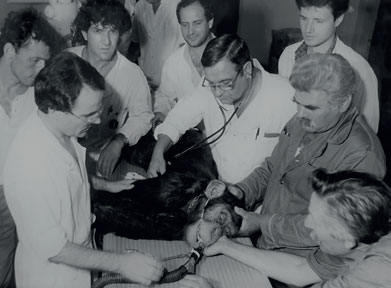 |
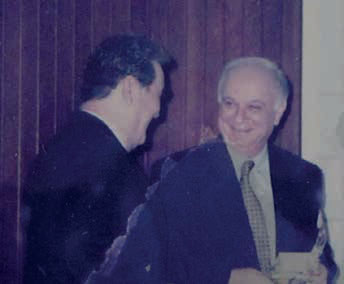 |
|
| Figure 20. Professor Raptopoulos (on the left) is anaesthetizing a chimpanzee for dental surgery and Professor Moustardas (on the right) is auscultating his heart (Picture taken in 1987 - author’s LP personal files). | Figure 21. Professor Dessiris on the left with Professor Papadopoulos at his retirement ceremony in 1999 (author’s LP personal files). |
The new era
In late nineties, a new era of veterinary surgery emerged and transformation of the Veterinary School took place; new blood entered the academia and contributed to the improvement of small animal orthopaedics, soft tissue surgery, neurosurgery, equine surgery, ophthalmic surgery and dentistry, along with others in anaesthesiology, analgesia and critical care. Sophisticated equine surgery including arthroscopy and abdominal surgery were also performed in racetrack equine hospital located in Athens. Many of these new faculty members received post graduate specialization abroad. In the early nineties, another veterinary school established in Greece associated with University of Thessaly. This increase in the number of schools equipped with modern surgical facilities allowed an increase in the number of practitioners performing sophisticated surgery and in the number of referral surgical practices located mainly in the two largest cities of the country, Athens and Thessaloniki. Universities contribute significantly to the dissemination of surgical knowledge throughout Greece by organizing continuing education seminars and conferences in collaboration with other veterinary associations. In the beginning of 21st century small animal and equine surgery will continue to set the pace and become more sophisticated as the number of these species continues to increase. Food animal surgery will decrease in volume, but its quality will improve following the advancements of veterinary surgery.
Conflict of interest
The authors declare no conflicts of interest.
References
- Archibald RM, Mitton AR (1954) Surgical Relief of Pyloric Stenosis in the Dog. Can J Comp Med Vet Sci 18, 394–396.
- Borthwick R, Robbie B (1969) Urography in the dog by an intravenous transfusion technique. J Small Anim Pract 10, 465-470.
- Bosshart JK (1930) Telescoped intestines in cattle. Cornell Vet 20, 55-58.
- Burns RHG (1960) Thoracic surgery in small animal. Aust Vet J 36, 189-192.
- Brook GB (1936) Experimental and clinical studies of spine in the dog. London, Bailliere Tindall and Cox.
- Cardoulis AG (2008) History of the Greek veterinary military corps. 2nd ed. Alta Graphico, Athens.
- Clemente GH (1966) Zur technik der resektionen an der rinderklaue. Tierarztl Umsch 21, 274-275.
- Cawley AJ, Archibald J, Ditchfield WJB (1956) Fractures of the femur in the dog. I. A technique for repair of fractures of the femoral neck. J Am Vet Med Assoc 129, 354-358.
- Curtis RA (1961) Momentary Upward fixation of the patella in a cow, and treatment by patellar desmotomy. Can J Comp Med Vet Sci 25, 314-316.
- Dessiris A, Gagatsis N (1969) Amputation of the digit in cattle. Veterinary News 1, 105-108.
- Dessiris A (1971) A case of megaoesophagus in a dog resulting from achalasia of the cardiac orifice of the stomach caused by Spirocerca lupi. Hellenic Vet Med 14, 105-112.
- Dessiris A (1972) Contribution to the study of myelography in the dog. PhD Thesis. Year Book of the School of Veterinary Medicine 13, 1-86.
- Dessiris A (1973) A case of incomplete oesophageal occlusion caused by the pressure of the common carotid arteries on the oesophagus in a dog. Hellenic Vet Med 16, 152-158.
- Dessiris A, Moustardas N, Papadopoulos T et al. (1973a) Semiology of paralyses following injuries of the main peripheral nerves of the legs in the dog. Hellenic Vet Med 16, 81-91.
- Dessiris A, Moustardas N, Papadopoulos T et al. (1973b) Fluothane anaesthesia in canine surgery. Vet News 4, 117-120.
- Dessiris A, Papadopoulos P (1973) The outline of the urinary system in the dog by the administration of an increased dose of a contrast agent and comparison of this method with the currently employed classic technique. Hellenic Vet Med 16, 1-14.
- Dessiris A (1974) Contribution to the study of compression osteosynthesis in the dog. Habilitation. Year Book of the School of Veterinary Medicine 15, 197-304.
- Dessiris A, Vlachakis-Miliaras E (1974) Observations on the effect of partial and total splenectomy in the dog. Hellen Iatr 43, 445-454.
- Dessiris A, Raptopoulos D (1974) A case of spastic syndrome in a cow. Hellenic Vet Med 17, 154-157.
- Dessiris A, Moustardas N (1981) Premature closure of the distal radial growth plate in the dog. Hellenic Vet Med 24, 53-60.
- Dessiris A, Papadopoulos P (1981) Causes and complications of osteosynthesis of diaphyseal fractures in the long bones in the dog. J Hell Vet Med Soc 32, 312- 323.
- Espersen G (1961) Cecal dilatation and dislocation. Mod Vet Pract 42, 25-27.
- Gagatsis N, Dessiris A (1970) An unusual case of ileus in cattle. Veterinary News 2, 40-41.
- Georgakis SA (2002) The Fifty Years of the Veterinary School of the Aristotle University of Thessaloniki. Thessaloniki
- Gibbens R (1957) Patellectomy and a variation of Paatsama’s operation on the anterior cruciate ligament of a dog. J Am Vet Med Assoc 131,557- 558.
- Grier RL (1968) Evaluation of invagination techniques in small bowel anastomosis in the dog. J Am Vet Med Assoc 153, 528-532.
- Hall LW (1957) Bromochlorotrifluoroethane (Fluothane): a new volatile anaesthetic agent. Vet Rec 69, 615-617
- Karatzias H, Raptopoulos D (1977) A case of osteochondritis dissecans of the lateral condyle of the femur in a dog. Hellenic Vet Med 20, 93-96.
- Karatzias H, Dessiris A (1978) Compression osteosynthesis of subcapital fractures of the femur in the dog. Hellenic Vet Med 21, 47-52.
- Karatzias H (1982) Untersuchungen zur diagnose und therapie von gelenkserkrankungen beim rind Inaugural-Dissertation. Hannover, Tierärztliche Hochschule
- Knight GC (1963) Transthoracic esophagotomy in dogs. A survey of 75 operations. Vet Rec 75, 264-266.
- Knowles AT, Knowles JO, Knowles RP (1953) An operation to preserve the continuity of the hip joint. J Am Vet Med Assoc 123, 508- 515.
- Lumb WV, Carlson WD, Patterson SA (1955) Pulmonary lobectomy in a dog. J Am Vet Med Assoc 126, 180-183.
- Michailidis A, Dessiris (1976) A. Hip dysplasia in the dog. Hellenic Vet Med 19, 195-201.
- Moustardas N (1974) Contribution to the study of the influence of cortisone on the porosis of fractures in the dog. PhD Thesis. Year Book of the School of Veterinary Medicine 15, 169-229.
- Moustardas N, Aslanoglou T, Dessiris A et al (1974) The use of oxytetracycline in the control of porosis of fractures in the dog. Hellenic Vet Med 17, 17-27.
- Nunamaker DM (1973) Repair of femoral head and neck fractures by interfragmentary compression. J Am Vet Med Assoc 162, 569-572.
- Papadaniel S (1939) Periarterial synpathectomy for the treatment of equine limb conditions. J Hell Vet Med Soc 15, 31-41.
- Papadopoulos PC (1963) Thoracic surgery in the dog. PhD Thesis. Aristotle University of Thessaloniki. Thessaloniki, pp. 1-71.
- Papadopoulos P (1965) A case of dilatation and dislocation of the cecum in a cow. Hellenic Vet Med 8, 205-210.
- Papadopoulos P (1966) Radical surgical technique for the treatment of otitis externa in the dog. Hellenic Vet Med 9, 78-84.
- Papadopoulos P, Formston C (1966) Observations on the reclination of the crystalline lens in the dog by means of the intra-vitreal injection of alpha- chymotrypsin and on the effect of this agent on the ocular tissues with special reference to the retina. Aspects on Comparative Ophthalmology. Oxford, Pergamon Press, pp. 329-340.
- Papadopoulos P (1967) Skin graft for replacement of anterior cruciate ligament rupture of the stifle joint in the dog. Hellenic Vet Med 10, 32- 35.
- Papadopoulos P. Gagatsis N (1967) Upward fixation of the patella in a cow. Hellenic Vet Med 10, 82-86.
- Papadopoulos P (1968) Contribution to the study of fractures of the head and neck of the femur in the dog. An experimental study. Habilitation. Year Book of the School of Veterinary Medicine 9, 393-472.
- Papadopoulos P, Dessiris A (1969) Surgical management of unreduced hip luxation in the dog. Hellenic Vet Med 12, 152-158.
- Papadopoulos P, Gagatsis N, Dessiris A (1970) Invagination in cattle. Veterinary News 2, 42-46.
- Papadopoulos P, Raptopoulos D, Dessiris A et al. (1985a) Experimental intestinal obstruction in cattle. Part I: Changes in the clinical picture. Zbl Vet Med 32, 264-275.
- Papadopoulos P, Raptopoulos D, Dessiris A et al. (1985b) Experimental intestinal obstruction in cattle. Part II: Changes in blood, urine and rumen content chemistry. Zbl Vet Med 32, 276-288.
- Papadopoulos P, Raptopoulos D, Dessiris A et al. (1987) Experimental intestinal obstruction in cattle. Part III: Therapy, outcome and autopsy findings. J Vet Med A 34, 7-12.
- Patterson FD, Munson OT (1958) Traumatic chylothorax in small animals treated by ligation of the thoracic duct. J Am Vet Med Assoc 133, 452-458.
- Pearson H (1973) The treatment of surgical disorders of the bovine abdomen. Vet Rec 92, 245-254.
- Pejas J, Dessiris A, Papadopoulos P (1976) Chylothorax in the dog. Hellenic Vet Med 19, 24-30.
- Petropoulos P, Vikelidis I. (1930a) Two cases of vagal paralysis. J Hell Vet Med Soc 3, 33-38.
- Petropoulos P, Vikelidis I. (1930b) A case of cauda equine neuritis. J Hell Vet Med Soc 3, 38-40.
- Pflug JJ, Calnan JS. (1969) Lymphatics: normal anatomy in the dog hind leg. J Anatomy 105, 457- 465.
- Raptopoulos D. (1976) Contribution to the study of the transplantation of bone in the dog. PhD Thesis. Aristotle University of Thessaloniki, School of Veterinary Medicine. Thessaloniki, pp. 1-115.
- Rosenberger G. (1978) Clinical Examination of Cattle. Verlag Paul Parey, Berlin, pp. 184-266.
- Saoulidis K, Dessiris A. (1972) A case of unilateral epiphysiolysis of the femoral head in a sow. Veterinary News 3, 9-10.
- Schnelle GB. (1959) Congenital dysplasia of the hip in dogs. J Am Vet Med Assoc 135, 234-235.
- Seibold HRWS, Bailey WS, Hoerlein BF et al. (1955) Observations on the possible relation of maligmant esophageal tumors and Spirocerca lupi lesions in the dog. Am J Vet Res 16, 5-14.
- Tsiamitas I. (1968) An experimental method of end-to- end anastomosis in the dog. PhD Thesis. Year Book of the School of Veterinary Medicine 9, 651-693.
- Vikelidis I. (1958) Fracture fixation in small animals. J Hell Vet Med Soc 9, 97-119.
- Vikelidis I. (1960) Treatment of fractures in large animals. J Hell Vet Med Soc 11, 117-132.
- Vikelidis I. (1964) Urolithiasis in the small animal. Etiological, biological, endocrinological, clinical observations. J Hell Vet Med Soc 14, 3-29
- Vikelidis I, Papadopoulos P. (1964a). Pyloric stenosis in the dog. J Hellenic Vet Med Soc 15, 245-251.
- Vikelidis I, Papadopoulos P. (1964b) Functional disturbances of the stomach in ruminants caused by vagal nerves injuries. Hellenic Vet Med 7,139- 153.
- Vlachakis- Miliaras E, Dessiris A. (1971) Study of normal lymphograms of the pelvic limb in the dog. Hellen Iatr 40, 820-828.
- Vitums A. (1961) Anomalous origin of the right subclavian and common carotid arteries in the dog. Cornell Vet 52, 5-15.
- Wiessner F, Wiessner W. (1952) Oberschengel fracturen bei schweinen. Wien Tierarztl Mschr 39, 613-621.
- Worthman RP. (1957) Demonstration of specific nerve paralyses in the dog. J Am Vet Med Assoc 131, 174-178.
- Zepp CP. (1949) Surgical technique to establish drainage of the external ear canal and corrections of hematoma of the dog and cat. J Am Vet Med Assoc 115, 91-92.
Corresponding author:
Lysimachos G. Papazoglou
e-mail: This email address is being protected from spambots. You need JavaScript enabled to view it.



